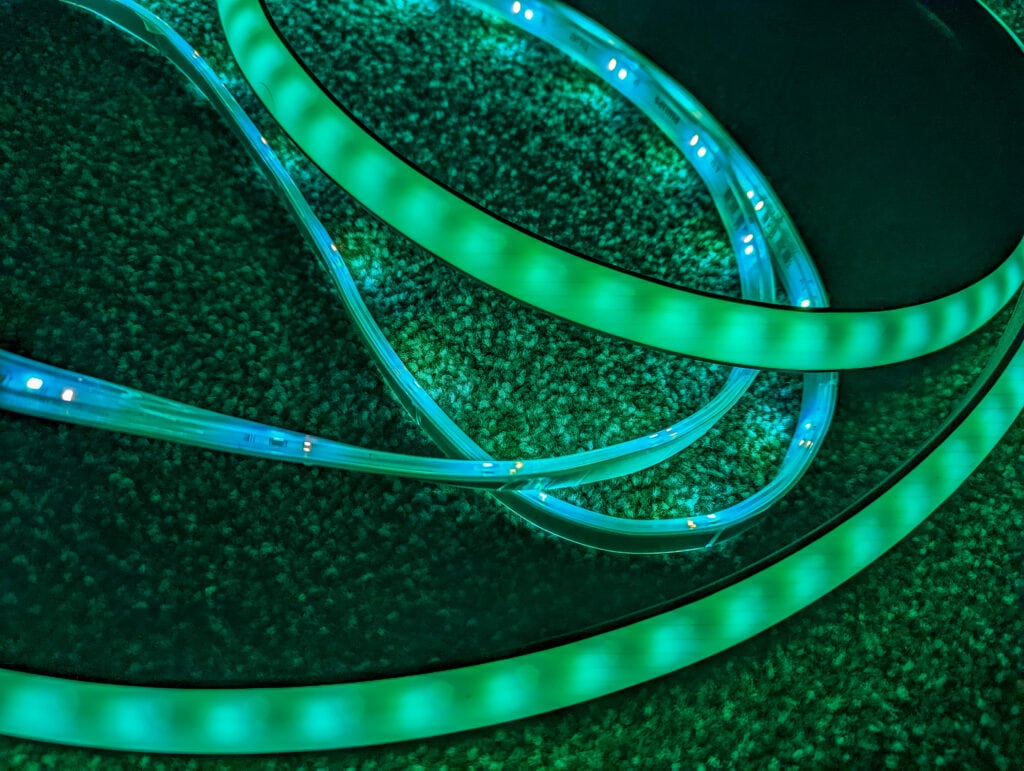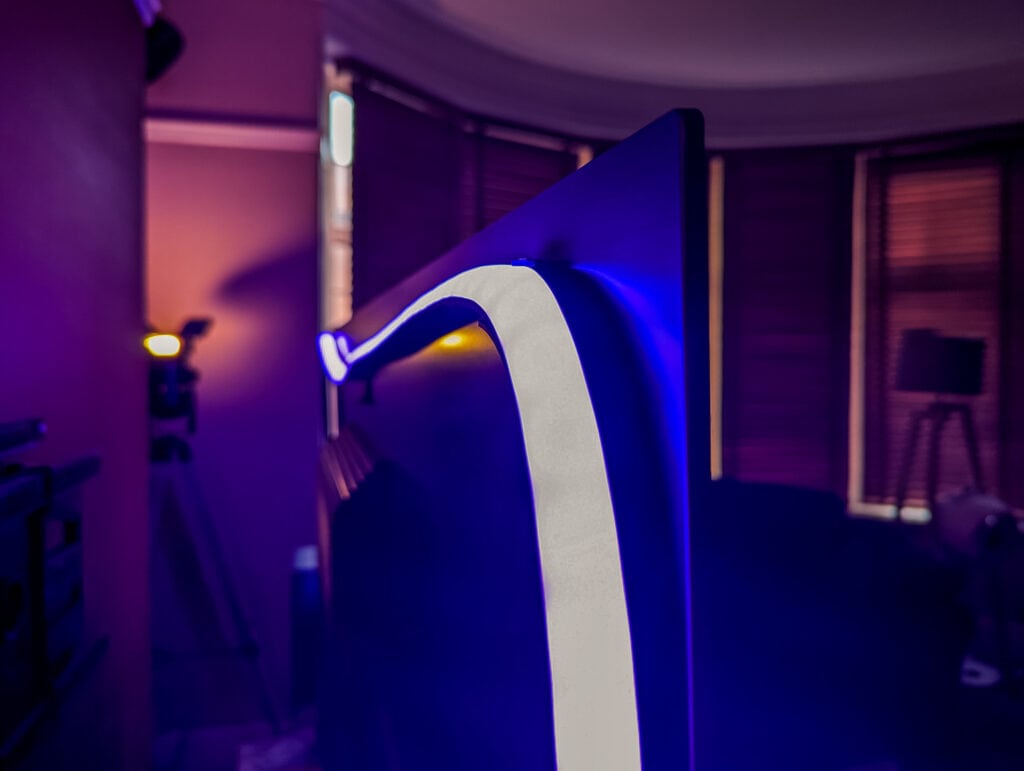Any links to online stores should be assumed to be affiliates. The company or PR agency provides all or most review samples. They have no control over my content, and I provide my honest opinion.
We all know that using LED lightbulbs saves a massive amount of electricity compared to traditional incandescent bulbs.
Incandescent bulbs were typically sold in 40W, 60W, 75W and 100W bulbs. Most large B22 or E27 LED bulbs cap out at around 10W and are often rated as 8W or 9W. Therefore, I have never paid too much attention to exactly how much electricity my bulbs use.
However, with energy costs rising exponentially, many of us are considering the running costs of electronics that we once assumed didn’t cost much to run.
I have slowly expanded my range of Philips Hue lighting so that I am now running all my bulbs, except GU10 spotlights, on Hue.
In a lot of homes, including ours, there has been a growing number of lights, it is not just about lighting anymore, but about creating a pleasant ambience.
This is obviously where Philips Hue has excelled. In my living room, I used to have one Philips Hue bulb in a lamp. That has now grown to two lamps, two play bars and the Signe Gradient Floor Lamp. I also had the 2m light strip, which I have switched out for the 65” gradient light strip.
Therefore, all those lower-powered lights could potentially cost a bit to run. But how much exactly?
Three questions I wanted to answer were:
- How much electricity does a Philips Hue bulb use when switched off?
- How much difference in electricity is there with the brightness levels?
- How much difference in electricity is there with the different scenes/colour levels?
I tested various Philips Hue products using an Energgenie power monitoring plug. I doubt it is the most accurate on the market, but the results should give you some idea of electricity usage.
Running Costs for Philips Hue
I have done several posts covering the cost of running appliances. I think everyone has been equally frustrated at the ambiguous price caps that get quoted. With the new Energy Price Guarantee, that price cap is now £2,500 for the next two years. But that’s probably not what you are going to pay.
Ofgem have provided a sample kWh price for users paying on direct debit:
- Electricity:
- £0.34 per/kWh
- Daily standing charge: £0. 46
Based on these numbers, I have added some sample costs of running each Hue product per hour. Again, it is probably not 100% accurate but it gives you a rough idea.
How much electricity does Philips Hue use?
Philips Hue White and Colour Ambiance Smart Light Bulb
| Preview | Product | Rating | Price | |
|---|---|---|---|---|

| Philips Hue White and Colour Ambiance Smart Light Bulb 2... |
£58.49 | Buy on Amazon |
- Off – 0.6W / 0.02 pence per hour / 0.48p per day
- White @ 100% – 7.3W / 0.25 pence per hour
- White @ 50% – 2.7W / 0.09 pence per hour
- Orange @ 50% – 2.2W / 0.07 pence per hour
- Orange @ 100% – 4.7W / 0.16 pence per hour
- Red @ 100% – 3.7W
- Red @ 50% – 1.6W
- Blue @ 50% – 1.8W
- Blue @ 100% – 2.2W
- Green @ 100% – 2.9W
- Green @ 50% – 1.8w
In the off state, I can’t be 100% if the plug socket is reading some of its own electricity usage or the overall accuracy of the power monitor plug. However, there is a small amount of electricity usage in the off state.
As this was just a single bulb with one colour to select, I manually chose the colour. For the following bulbs, they all have multiple colours to select, so I select scenes instead.
Philips Hue Lightstrip Plus v4 [2 m]
| Preview | Product | Rating | Price | |
|---|---|---|---|---|
![Philips Hue Lightstrip Plus v4 [2 m] White and Colour...](https://m.media-amazon.com/images/I/41HPqzdjuxL._SL160_.jpg)
| Philips Hue Lightstrip Plus v4 [2 m] White and Colour... |
£43.44 | Buy on Amazon |

- Read @ 100% – 15W / £0.00510 per 60 minutes
- Read @ 50% – 3W / £0.00102 per 60 minutes
- Tropical Twilight @ 100% – 4W / £0.00136 per 60 minutes
- Tropical Twilight @ 50% – 1W / £0.000340 per 60 minutes
For this one, electricity usage is incredibly low, but when you compare it to the brightness of the Gradient Lightstrip, you can understand why.
Philips Hue Play White and Colour Ambiance Smart Light Bar
| Preview | Product | Rating | Price | |
|---|---|---|---|---|

| Philips Hue Play White and Colour Ambiance Smart Light Bar... |
£94.42 | Buy on Amazon |
- Read @ 100% – 6.6W / 0.002244 per 60 minutes
- Read @ 50% – 1.3W / £0.000408 per 60 minutes
- Tropical Twilight @ 100% – 5.2W
- Tropical Twilight @ 50% – 1.4W
These are sold as a two-pack, but the above number is for a single Hue Play, so you will need to double it for normal use.
Philips Hue Gradient Lightstrip for 65-Inch TV
| Preview | Product | Rating | Price | |
|---|---|---|---|---|

| Philips Hue Gradient LED LightStrip 65in (Sync with TV,... | £179.99 | Buy on Amazon |

- Arctic Aurora @ 100% – 15W / 0.51 pence per hour
- Arctic Aurora @ 50% – 3.5W / 0.12 pence per hour
- Read @ 100% – 21.2W / 0.72 pence per hour
- Read@ 50% – 5.9W / 0.20 pence per hour
- Tropical Twilight @ 100% 14.5W
- Tropical Twilight @ 50% 3.5W
- Bright @ 100% 21.3W
Philips Hue Signe Gradient Floor Lamp
| Preview | Product | Rating | Price | |
|---|---|---|---|---|

| Philips Hue Signe Gradient White & Colour Ambiance Smart... |
£251.00 | Buy on Amazon |


- Off – 1.4W / 0.05 pence per hour / 1.2p per day
- Read @ 100% – 27.7W / 0.94 pence per hour
- Read @ 50% – 8.9W / 0.30 pence per hour
- Tropical Twilight @ 100% – 8W / 0.27 pence per hour
- Tropical Twilight @ 50% – 5.7w / 0.19 pence per hour
- Energy @ 100% – 25.2W
- Energy @ 50% – 7.8W
- Spring Blossom @ 100% – 17.6W
- Spring Blossom @ 50% – 7.8W
Overall
The results ended up a bit more interesting than expected. I know Philips Hue has mentioned reduced electricity usage for different hues in some press material, but I didn’t think it would make that much difference.
Similarly, I was surprised at how the power usage scales. The logical assumption would be roughly twice the electricity at 100% vs 50%, but it is considerably more than this in almost all of the scenarios.
Thankfully I never have my living room lights at 100%, and I nearly always use a red/orange/pink hue as it is easier on my eyes. So, my overall electricity usage is still likely very low!
I am James, a UK-based tech enthusiast and the Editor and Owner of Mighty Gadget, which I’ve proudly run since 2007. Passionate about all things technology, my expertise spans from computers and networking to mobile, wearables, and smart home devices.
As a fitness fanatic who loves running and cycling, I also have a keen interest in fitness-related technology, and I take every opportunity to cover this niche on my blog. My diverse interests allow me to bring a unique perspective to tech blogging, merging lifestyle, fitness, and the latest tech trends.
In my academic pursuits, I earned a BSc in Information Systems Design from UCLAN, before advancing my learning with a Master’s Degree in Computing. This advanced study also included Cisco CCNA accreditation, further demonstrating my commitment to understanding and staying ahead of the technology curve.
I’m proud to share that Vuelio has consistently ranked Mighty Gadget as one of the top technology blogs in the UK. With my dedication to technology and drive to share my insights, I aim to continue providing my readers with engaging and informative content.
Last update on 2025-07-13 / Affiliate links / Images from Amazon Product Advertising API





![Hoover H4 Cordless Vacuum Review Hoover HF4 Cordless Vacuum Cleaner Review [Pets Edition] vs HF9 & HFX](https://mightygadget.co.uk/wp-content/uploads/2024/02/Hoover-H4-Cordless-Vacuum-Review-768x578.jpg)


Thanks for this, very useful info!
Think you need to check the maths here, some are way out
You have confused Watts with Kilowatts. Need to divide all your costs by 1,000!
Oh how embarrassing. Yes I have. Thanks for highlighting that
Actually, not sure I have. I checked against an online calculator and that confirmed my numbers. I listed things in pence per hour many, all of which ara a fraction of a pence.
According to the calculator 27.7W is £0.009418 per 60 minutes and I have stated 0.94 pence per hour using the Philips Hue Signe as an example.
Happy to be corrected if I am being dumb and missed something!
Your numbers are correct. Scanning your article you started with £0.34 per/kWh and then next paragraph wrote ‘Off – 0.6W / 0.02 pence per hour / 0.48p per day’. I read it as £0.48 per day. Suggest you stay with either £ or pence throughout article.
Good point. Thank you for the feedback.